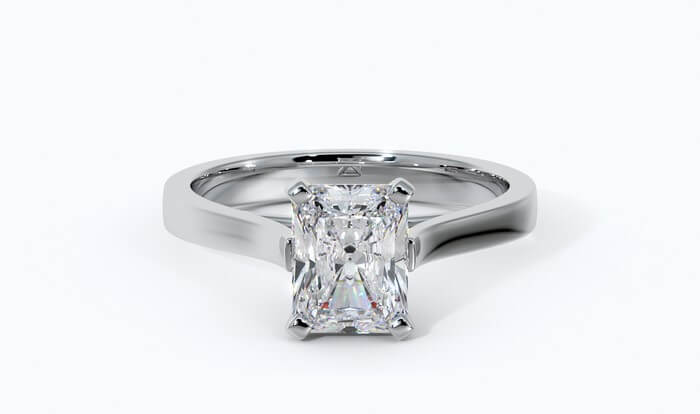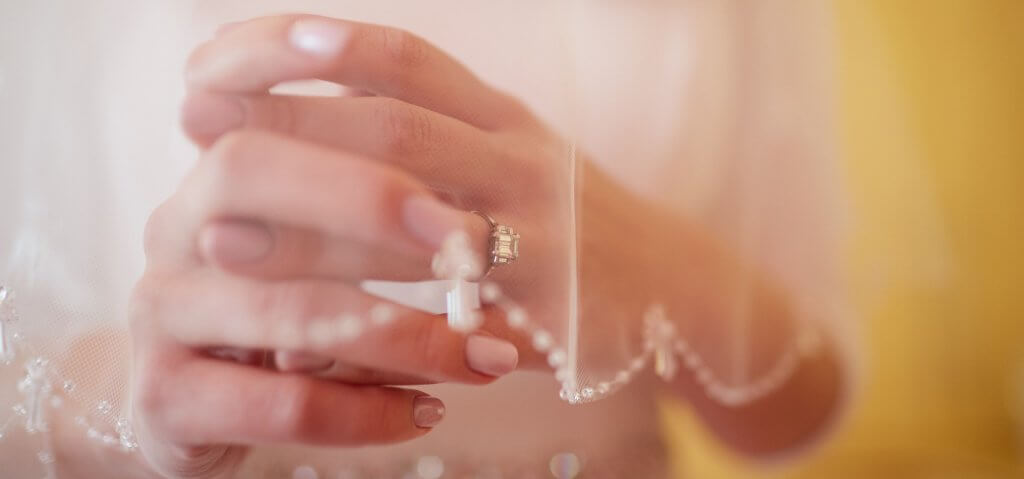The Floating Diamond Engagement Ring Guide
Key Takeaways
- A floating diamond engagement ring can be an incredible example of craftmanship and delicacy.
- A floating diamond will appear to hover above the shank and the wearer’s finger.
- Compared to other settings, more of the diamond is exposed, particularly the sides.
- They are secured into place using tension, open bezels, or bars that create a fine lip over the edge of the diamond.
- If it is made well, then it will also be very secure, even though it may not look like it is.
- The issue with a floating diamond, however, is that there are more opportunities for the diamond to snag.
- It is a demonstration of skillfulness and a perfect opportunity to show off the diamond, however you will need to talk to your jeweler about how suitable it might be for your lifestyle.

The architectural elements of a ring are often part of the appeal. From the elegant structure of a Cathedral to the delicacy of the prongs – seemingly as delicate as a drop of water – the details beyond the diamond are captivating in their own right.
Even so, they are always secondary to the diamond. Our eye is caught by the brilliance and fire – the bright shine and the perfect shape – before anything else, and it seems safe to say that most shoppers want to be able to keep as much of the diamond untouched by structural elements as possible, without risking it falling out. Prongs are there for a reason, after all.
That’s why the floating diamond design represents the ‘final frontier’ in ring design. As much as possible, the jeweler works to eliminate excess metalwork, and conceal the parts that are absolutely essential – and believe us when we say that it takes a lot of creativity and expertise to make a diamond appear capable of defying gravity.
Done right, the results are truly spectacular – and, if you can believe it, perfectly safe for your diamond.
What Does a Floating Diamond Look Like?
It really does appear to be hovering above the shank – and above the wearer’s finger.
Compared with other, more traditional ring settings, much more of the diamond is exposed – particularly the sides – meaning the wearer can appreciate every aspect of the stone. It’s a great way to show off an excellent diamond cut, and the silhouette of your chosen shape.
Floating diamond engagement rings can follow many different designs. The diamond might be positioned alongside the shank – held in place by well-disguised metalwork, the stone will appear to skim the edge of the band, making minimal contact.
One of the most common designs shares similarities with the tension setting, which appears to graze the edges of the diamond, rather than clamping it in place with a great deal of force.
The open bezel is also a popular technique for floating a diamond. Rather than encircling the diamond, the bezel wraps around little more than half. A single prong might be used to secure the ‘open’ portion, creating the illusion that the diamond could break free at any moment.
Floating halo engagement rings are also a popular style. Instead of encircling the edge of the diamond, where the crown meets the girdle, the halo sits lower than the diamond and, as a result, the diamond appears to be rising up from the ring’s center, away from the finger and into the airspace above.
In any case, these rings are united by a mastery of ring design, and a near-magical touch that almost appears to make the metalwork redundant. They make the most of the diamond from every angle and maximize sparkle by giving the stone as much access to the light as possible.
How Do Floating Diamonds Work?
While it depends on the ring’s other design elements, floating diamonds are generally secured in place using tension, open bezels, or bars that create a very fine lip over the edge of the diamond.
Jewelers can also create a special kind of split shank design known as a bypass, where the two (unconnected) ends of the shank run either side of the diamond without ever meeting. They can hold the diamond in place using tension, or by creating a barely noticeable channel that prevents the diamond from moving or slipping out of place.
It’s often easier to create the illusion of a floating diamond in white gold or platinum settings, since any lips or tiny prongs are far less likely to prove noticeable if their color blends with the white shine of the diamond.
The contrast of yellow and rose gold will mean that any minor overlaps between the diamond and metal will be emphasized.
Of course, this is only useful for white diamonds. For colored diamonds, achieving this effect is a little more challenging.
Do Floating Diamonds Fall Out?
It’s possible that a hard knock could undermine the metalwork, but this is true of any ring design (save for a bezel, which is about as safe as they come). A well-made floating diamond ring will be very secure.
It’s likely that a floating diamond will be a little more vulnerable to working loose or falling out than a regular four- or six-prong ring, but they are a lot more secure than they appear.
The mark of a beautifully made floating diamond ring is its ability to fool you into thinking that it’s held in by a feather-touch, and sheer willpower. It takes an element of bravery to wear a ring that appears so fragile, but, provided it has been made by a skilled jeweler, it’s definitely a lot stronger than you think.
Remember that a floating diamond is more vulnerable to being knocked. If the diamond’s girdle is too thin, or any delicate points are left exposed, there is a definite risk of them chipping. It’s important that you keep this in mind but remember that a good jeweler will talk you through everything – and will strongly advise you away from any diamonds that aren’t up to the job.
Do Floating Diamonds Snag?
If they are set high above the rest of the ring, then they are a lot more likely to snag and may not be easy or convenient to wear if you lead a busy lifestyle.
Most engagement rings will snag initially. It takes some time for the wearer to get used to having it on their finger, and the first couple weeks will probably be a learning curve – even if they’re used to wearing rings.
But, as you can imagine, the higher or bulkier a ring is, the more likely it is to snag on clothing. Bulkier settings like halos are often guilty of this, as well as solitaires holding diamond shapes with sharper points, like the Princess cut (with its four angular corners) or the Pear (with its distinctive point).
Over time, snagging can work the setting loose and put your diamond at risk, so, as always, it is very important that you pay regular visits to the jeweler who made the ring. That way, they can clean and inspect the ring for anything that may need a quite tune-up, and you can worry less about the longevity of your floating diamond.
Our Summary
The floating diamond is a perfect example of a jeweler’s skill – their ability to keep their work ‘behind the scenes’, and to create something that seems to work against the laws of nature. They are also the ideal way to show off a beautiful diamond from every angle, and avoid the setbacks of, say, a bezel or halo engagement ring, which tends to obscure most of the lower portion of the diamond from view.
These rings are secure, but they’re often a little more daunting to wear – and, at times, harder to get used to – than some of the more popular ring styles. We’re not saying that the intended wearer won’t get used to wearing a floating diamond engagement ring, but that you’ll want to talk to your jeweler about ensuring it will be comfortable to wear on an average day.
Once you nail down the specifics of the design, however, you’ll see how strong a choice a floating diamond engagement ring can be. Stripping back the metalwork to the bare necessities is the best way to celebrate the full, 360° beauty of your diamond, and avoid losing any of it to the architecture of the ring itself.
As always, you’ll want to work with a jeweler who has truly mastered the art of creating exquisite engagement rings. Use our Jewelry Store Locator to find a jeweler working in your area who comes recommended by us, and the local community.

Mar 17, 2022 By Willyou.net
What is an Elongated Cushion Cut Diamond? Everything You Need to Know

Mar 12, 2022 By Willyou.net
4 Prong vs 6 Prong Engagement Rings: Which is Best for You?








